Jomon Journey of nawa to yajiri
English is available after Japanese.
For other languages, please click here.
次の日、宿を出発した私たちは、まだ当時リニューアル前の十日町市博物館を訪れ、この地域から出土した国宝の火焔土器をはじめとするさまざまな出土品をみた。とくに国宝指定番号1番の火焔土器はスリムな胴部を持つ均整の取れた形をしており、5,500年の時を経てほぼ完形で出土したことが奇跡のようだと思った。
その後、国宝が出土した笹山遺跡へ車を走らせる。博物館のある市街地から飯山線の線路を渡り、ゆるやかな坂をのぼっていくと、芝生の傾斜地に竪穴住居が2棟復元されているのがみえた。周囲は陸上競技場や野球場のある運動公園になっていて、車から降りると、スポーツにいそしむ子どもたちの掛け声が聞こえてきた。
それにしても、遺跡に来れば何かわかるかと思っていたが、現代において縄文時代の雰囲気を感じとるのは難しい。芝生はきれいに刈られていて歩きやすいが、現代の公園感は否めない。また、発掘調査を終えた笹山遺跡は一部を保存してあるというが、ほとんどは運動公園の建設時に失われてしまっているのだ。縄文時代を想像する手がかりは地形のみということになる。
笹山遺跡は坂の上にあるため、おそらく眺めはよいのだと思う。しかしこの日は曇りで、期待するようなパノラマは望めそうもなかった。ポツポツと雨が降り出してきたので、車に退散し、津南に戻ることにした。行き先は信濃川に注ぐ支流の中津川沿いにある津南町歴史民俗資料館だ。
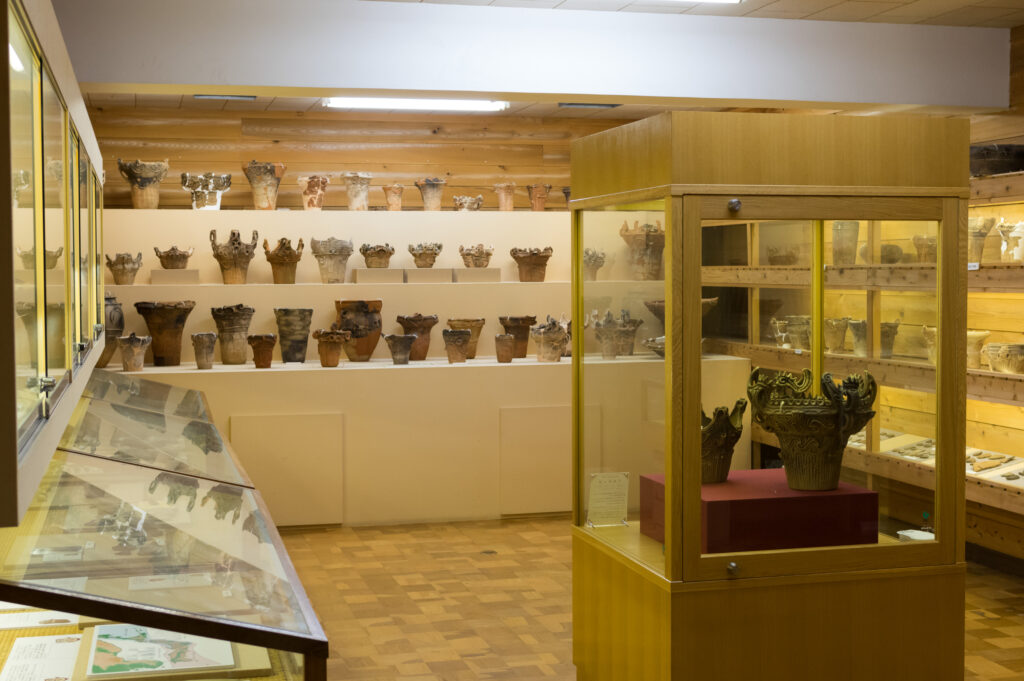
歴史民俗資料館は、茅葺屋根の古民家が併設された蔵造り風の建物で、民具の展示室がある2階と考古展示室の3階に分かれている。受付を済ませ、スリッパに履き替えて中に入ると、古い建物特有の匂いがした。
まずは3階へ上がり、部屋の真ん中のガラスケースに鎮座する国重要文化財の堂平遺跡の火焔土器をみる。その隣には、火焔土器と対で出土するという王冠土器がおだやかな雰囲気をたたえて並んでいた。縄文時代の人々は祭祀をしていたことがあきらかになっているが、儀礼具のような使い方をする特別な土器だったのだろうか。真相はわからないが、ペアでみると、男と女、大人と子ども、動と静、そんな風にもみえる。ものごとには両面があると、土器に諭されているような気分だ。
隣でガラスケースを覗き込んでいた廣川が、「もはや鍋じゃないよね」という。
そう、忘れていたがこれは鍋なのだった。縄文土器の造形を「器放れ」と言い表したのは、長岡出身の考古学者、小林達雄だが、みているこちらも器であることをすっかり忘れてしまっていた。
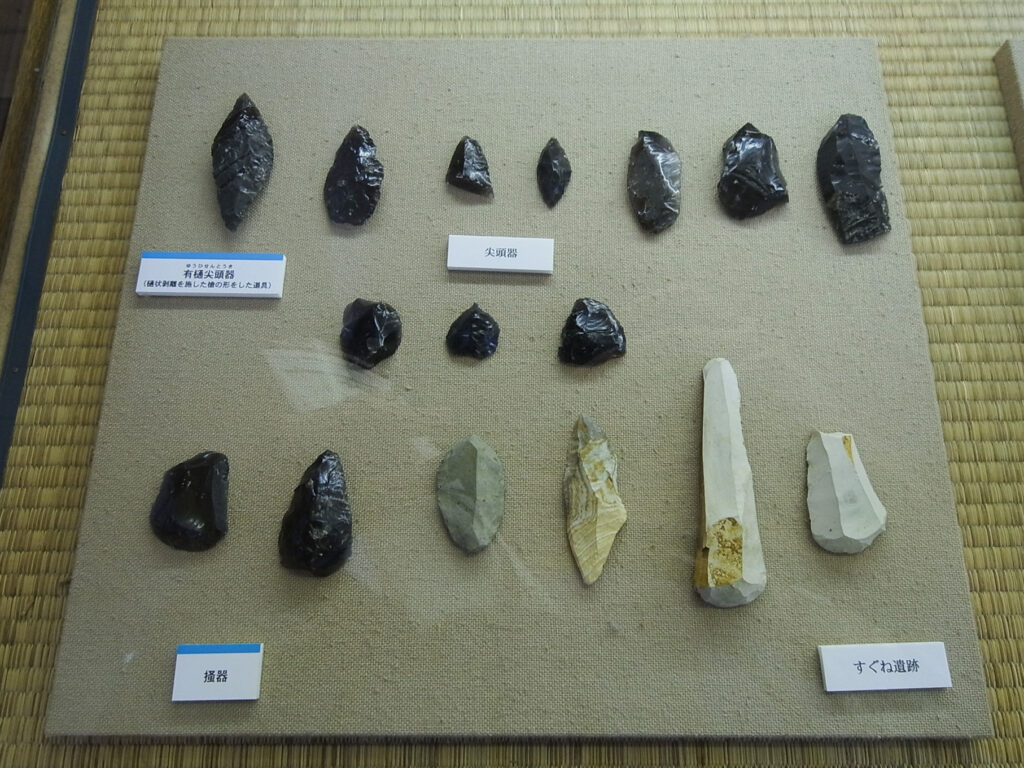
次に壁際に陳列された石器類をみる。もっとも古いものは、縄文以前の旧石器時代、約27,000年前の正面ケ原D遺跡の打製石器で、縄文時代になると、動物の皮をはぐのに使われた石さじや、美しく磨かれた磨製石斧、艶やかで鋭く尖った黒曜石のナイフ、穴の開いたヒスイなど石器のバリエーションが増えるのがわかる。いずれも考古館でよくみるおなじみの遺物だが、ヒスイや黒曜石製の石器には産地との近さを思わずにいられなかった。日本で唯一のヒスイの産地はここからそう遠くない新潟県南西部を流れる姫川流域にある。そして黒曜石の大産地は先述したとおり千曲川(信濃川)の上流部にあるのだ。川でつながる津南はどちらの石材も得やすい地域だったのではないだろうか。
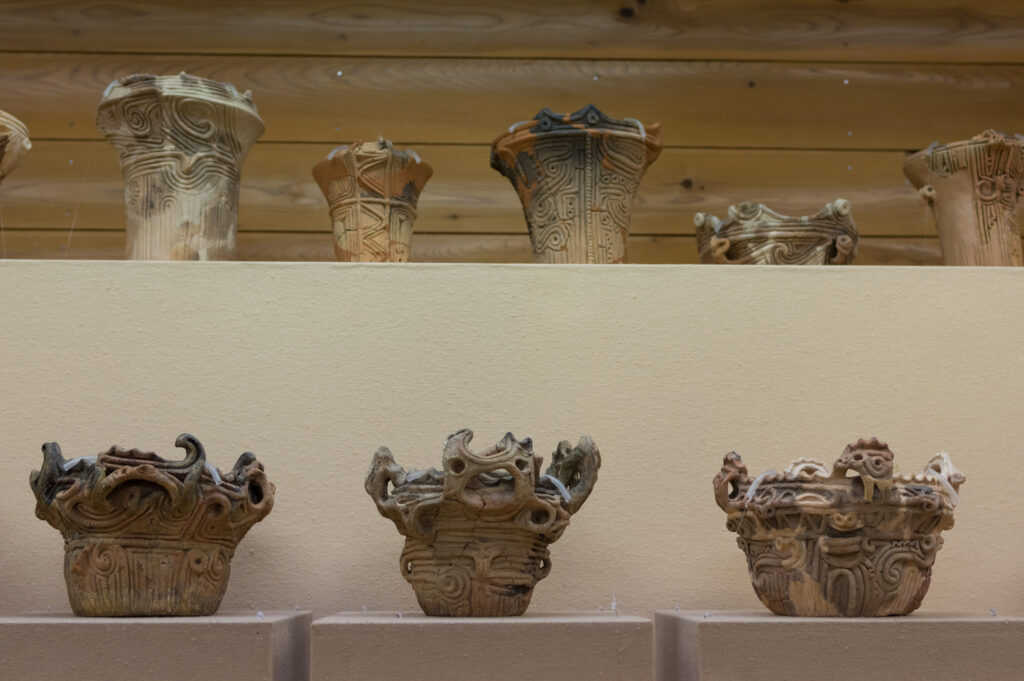
奥の壁際にあるひな壇に道尻手遺跡の土器が展示されていた。ほとんどが深鉢で、高さが目測で20〜30cmくらいのものが多い中、火焔土器を上下につぶした、小鍋のような土器に目が止まる。小さくてもしっかり火焔土器の特徴である鶏頭冠がついていて、とてもいじらしい。
道尻手遺跡では火焔型ばかりではなく明らかに違うデザインの土器も出ているようだ。それらをみて、懐かしさを感じたのは、過去に北関東や中部高地、浅間山麓などでお目にかかった土器に雰囲気が似ていたからだ。ただ、現地のものともなんだか違うような気がする。特徴的な形、文様をこの地の縄文人が再現してみた、そんな感じだ。
とくに中部高地で見られる有孔鍔付土器のようなレアな土器がこの地域でも平然と出ていることが意外だった。丸々とした樽のような有孔鍔付土器は太鼓説や酒造具説のある祭祀をイメージさせる土器なのだ。
縄文時代に土器の情報は直接人間によって運ばれたのだと思うが、よく言われる婚姻や交易のほかに、祭りに人が集まりそこでみたものを模倣するようなケースもあったのかもしれない。
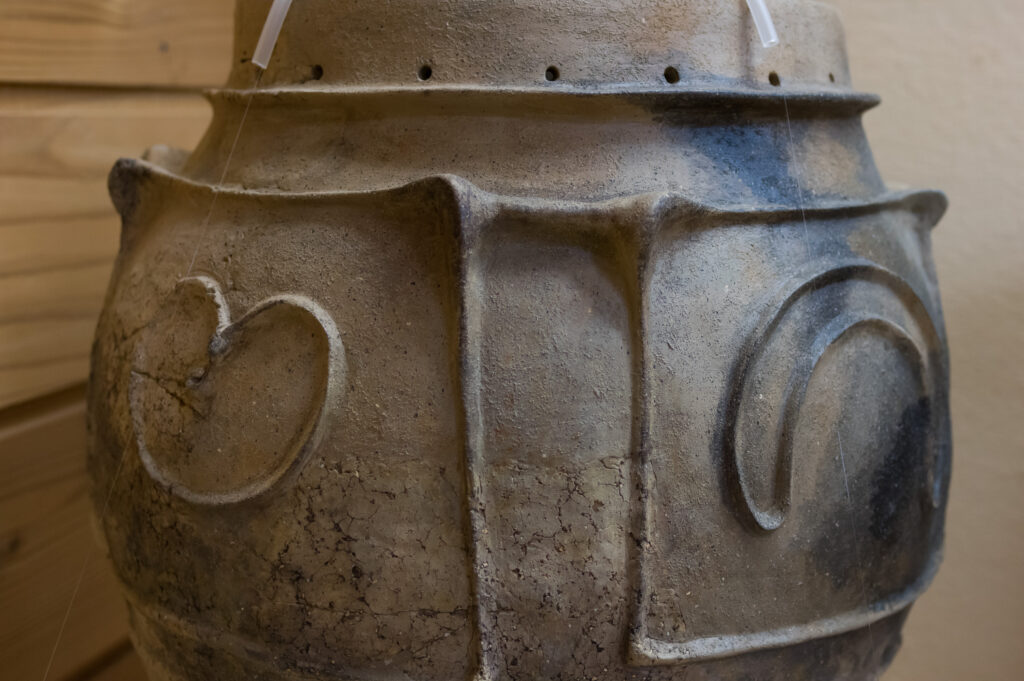
それにしても、土器をみすぎて食傷気味になってきた。そこで2階の資料室へ降りると、中津川上流部のマタギの里で知られる秋山郷の民具が集められていた。縄編みの背負いかごや、木の二又部分を切っただけの叩き棒(穀物を処理する作業に使う)といった、周りの自然を利用した素朴な道具が所狭しに並んでいて、縄文時代から連綿と続く山暮らしの痕跡をみているようだった。終わらない夢の中にいるような不思議な気分になったのは、言うまでもない。
外に出ると雨は止んでいた。時計をみると午後2時をまわっていたので、慌てて飲食店を探し、田んぼの中にポツンと一軒たたずむラーメン店に入り、具がたっぷりのった辛めのラーメンでお腹を満たした。なじょもんでもらった苗場山麓ジオパークの地図を開き、ここからほど近い国指定史跡の沖ノ原遺跡に行くことにした。
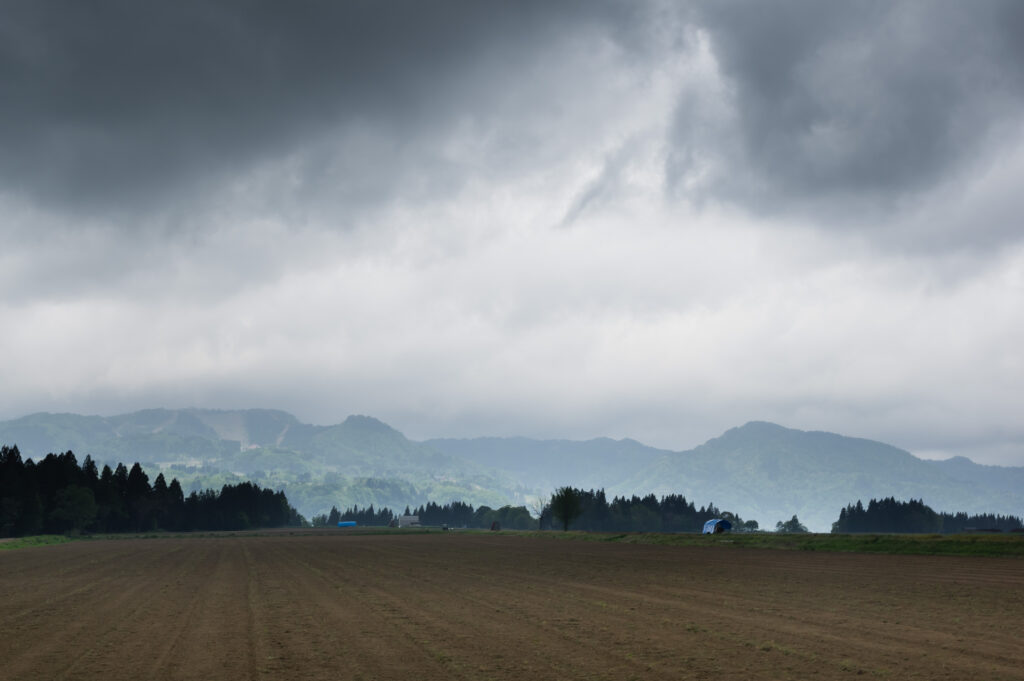
沖ノ原遺跡は信濃川と中津川に挟まれた河岸段丘の上にあった。河岸段丘といっても川床との高低差は160mくらいある。下からみると真っ平らな山のようにみえたが、坂道を車で登っていくと広大な畑作地帯になっていて驚いた。川が流れる下の世界は田んぼとして利用し、河川のない台地の上は畑として利用しているのだろう。耕したばかりの畑はふかふかとしてとてもやわらかそうだ。
静かな農道をゆっくり走ると雑草が茂る草むらがあり、「国指定史跡 沖ノ原遺跡」と書かれた標柱が所在なげに立っていた。竪穴住居もたっていなければ、観光客向けに整備がされているわけでもなかった。しかし、その野放しの感じが、逆に自然の状態に近く、縄文時代を想像するには都合がよい。
道端の遺跡案内板によると、ここでは約5,300~4,000年前に営まれた、広場を中心とする環状集落跡が見つかっているそうだ。3度に渡る発掘調査でみつかったのは、竪穴住居跡49基に大型住居跡3基、敷石住居跡1基に、火焔土器をはじめとする土器や石器、クッキー状炭化物など。遺跡の存続期間はおよそ700年と推定されている。それらは、壊されることなくこの足元に眠っていて、今後も発掘調査が計画されているという。
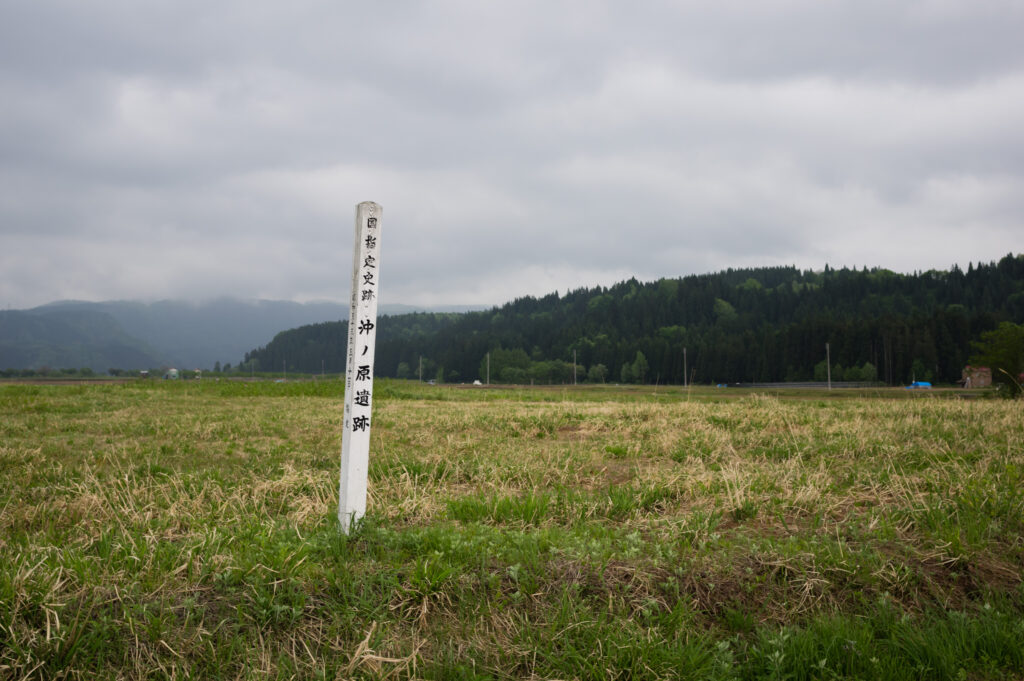
特筆すべきは大型竪穴住居跡が出ていることかもしれない。竪穴住居を横に伸ばしたような大型竪穴住居は青森県の三内丸山遺跡に復元されているものがあるが、北陸や東北のような雪国に出土例が多く、冬期の共同作業小屋や儀礼・祭りなどを行う集会場などさまざまな説を持つ建物だ。
一年の半分近くを冬が占める津南では、毎年3mもの雪が降り積もるが、その大雪をもたらす対馬暖流が日本海に流れ込んだのは、およそ8,000年前からと考えられている。5,500年前にしっかり雪が降っていたのなら、大型竪穴住居での越冬説が真実味を帯びてくる。
縄文ムラの人々が力を合わせて冬を乗り越えるには、まず集まる場所が必要で、火の焚かれた暖かい大型竪穴住居が広場の役割を果たしていたようにも思うからだ。
とはいえ、冬の間だけもっと暮らしやすいところへ移住するという手もあるかもしれないが……。真相は今後予定されている発掘調査の結果を待ちたいと思う。
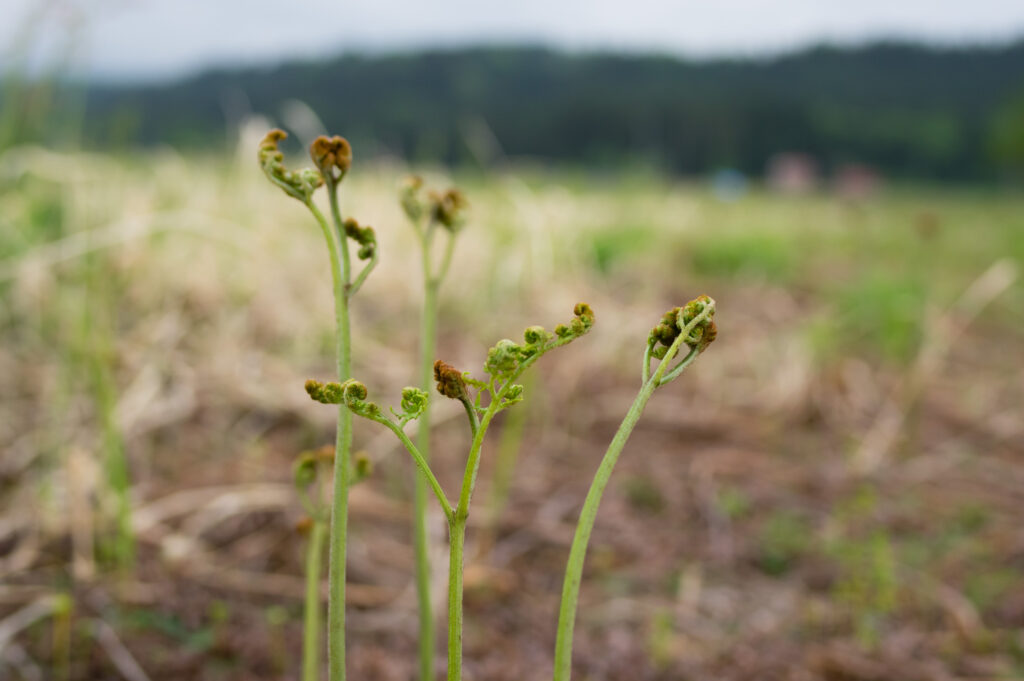
雲が低く垂れ込め、今にも降りだしそうだった。冷たい風が山の方から吹いてきて、足元の草むらをゆらした。よくみると、それはワラビだった。周囲を見渡すと至るところに生えている。ふだん山菜をとりに行ったことのない私たちだが、目の前に食品が生えているとなると話は別だ。「どうぞとってくれ」と言わんばかりに風にそよぐワラビをみて、色めきたってしまった。そして、思ったのだ。このようなワラビをみたら、縄文人も血が騒ぐのではないかということを。
自然がくれるさまざまな恵みを糧に生きていた縄文人にとって、ワラビは貴重な食料源だったと思う。いや、ワラビだけではない。長い冬を明ければ、春一番にフキノトウが芽を出し、ゼンマイ、コゴミ、ウド、タラノメなど豊かな食の季節がめぐってくる。それは厳しい冬を生き抜く上で大きな喜びになるように思う。
山に降り積もった雪は春になると溶け出し、大量の伏流水となって野山をうるおす。湧水が集落の近くで出ているなら、水を目当てに動物が集まり、狩もしやすいように思う。ここは冬を乗り越えれば、狩猟採集に必要な条件がそろった暮らしやすい土地なのではないだろうか。
水は暮らしに欠かせない。豪雪地帯の縄文人が700年もここに暮らし続けた理由のひとつに、水が関係しているように思った私たちは、沖ノ原遺跡から3kmほどの距離に日本名水百選に選ばれた龍ヶ窪へ向かった。そして、その思いは確信に変わったのである。
龍ヶ窪は、杉木立を降りていった森の中にあった。植生がいつの間にかブナを含む広葉樹林に変わり、混じり気のないクリアな水にその新緑が鏡のように映し出され、すべてが緑色に染まっていた。思わず歓声をあげたくなるほどの美しさだった。
それなりに大きい池で、約1.2haの面積がある。後から調べると、ここは30万年前に苗場山の溶岩流が止まった場所で、溶岩台地に染み込んだ水がここで湧き出す仕組みになっているそうだ。その湧出量は、なんと毎分18〜30トン。池の水が1日で入れ替わるため、ここは濁ることもなく透明な水をたたえている。
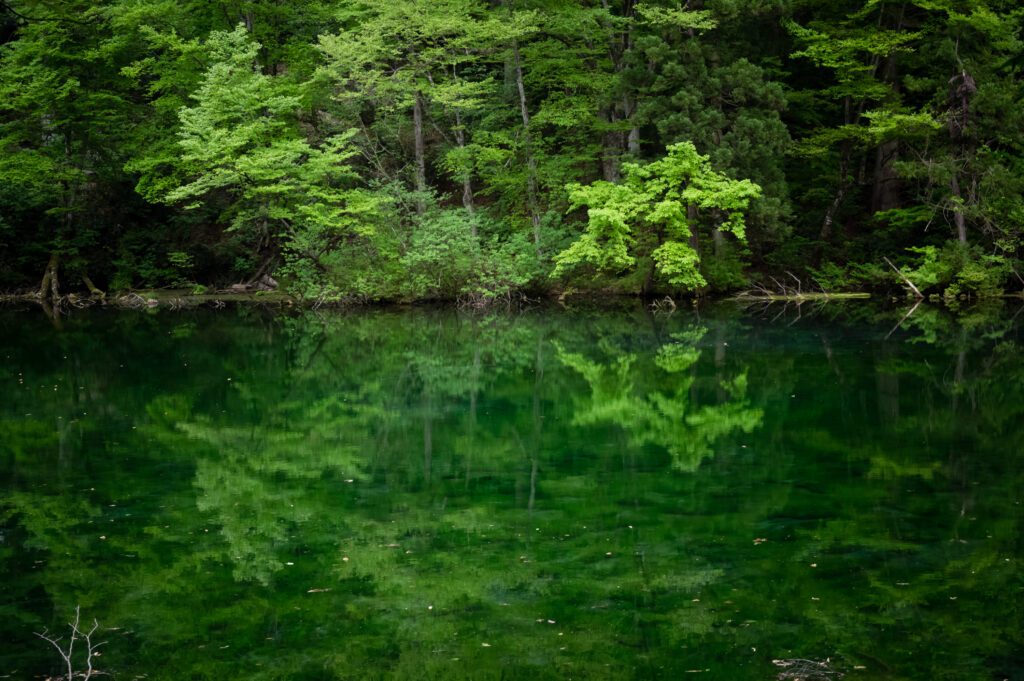
池のほとりの小さなお宮の下に取り付けられた湧水口から水を飲んでみると、口当たりがやわらかくのどごしもさわやかな超軟水。めちゃくちゃおいしいのである。この水が飲めるのなら、ここに住んでもいいとすら一瞬思ったくらいだ。
やはり人気があるのか、水を汲みに来ている人もいた。私たちも持参したボトルに水を汲み、池をめぐる遊歩道の対岸にある龍ヶ窪神社に向かって歩いた。鳥のさえずりが聞こえてきて気持ちがいい。
歩きながら、湧水は水道のない時代にとても価値ある場所ではなかったかと考えた。川はいつ氾濫するかわからない危険性を秘めているが、湧水なら濾過された飲料に適した水を安定して得ることができる。大量の積雪量を背景に新鮮でおいしい水が常に供給されるこの場所は、河川のない台地上で暮らしてきた人々の生命線だ。だからこそ、ここは聖域として守られてきたのだろう。
龍ヶ窪神社にお参りをしてから池に手をひたすと、ものすごく冷たかった。社殿後方の溶岩台地のキワから渾々と水が湧き出ているのを確認し、私たちはやっと帰路についた。
火焔土器のふるさと津南は、日本一の大河が流れるおいしい水の湧く場所だった。それ以来、私は火焔土器のあの形が“火”ではなく“水”なのではないかということをひそかに思っている。
※考古学の分類で火焔土器は「火焔型土器」と表記されますが、ここでは読みやすさを考慮し「火焔土器」に統一しました。
草刈朋子:文 廣川慶明:写真
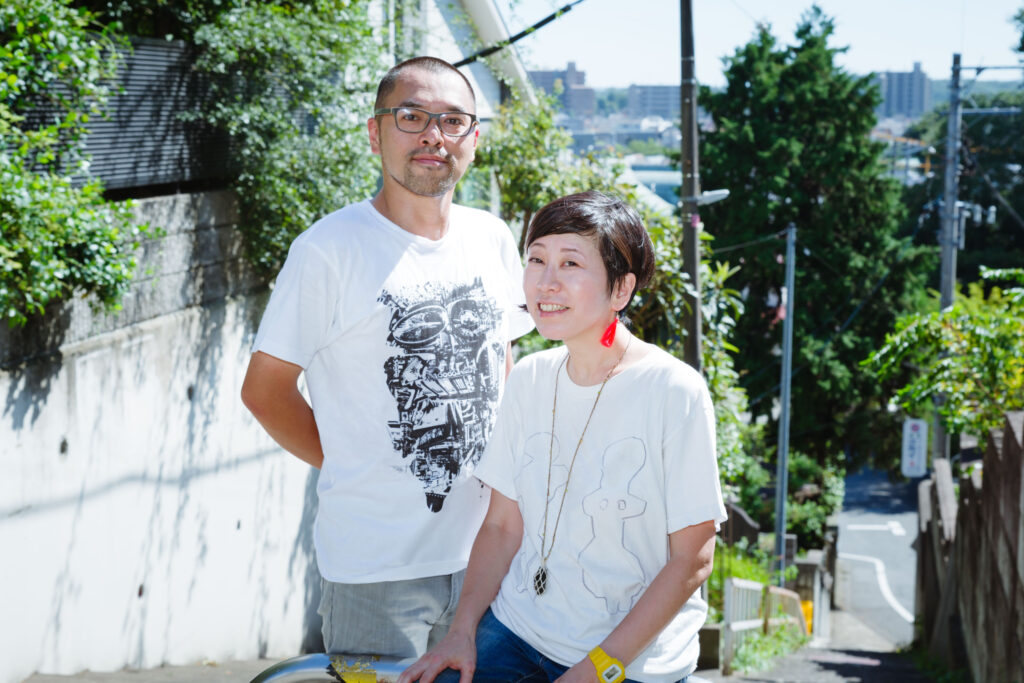
縄と矢じり
文章担当の草刈朋子と写真担当の廣川慶明による縄文探求ユニット。ともにNPO法人jomonismのメンバーとして活動するほか、全国の縄文遺跡と考古館や郷土館をめぐる縄文旅をしながら各地の縄文のカタチ、環境から読み解ける先史時代の価値観を探求中。
http://nawatoyajiri.com
The next day, we left the inn and visited the Tokamachi City Museum, which was not renovated at the time, to see the various artifacts excavated from the area, including the national treasure, Jomon Vessel with Flame-like Ornamentation. In particular, the Jomon Vessel with Flame-like Ornamentation, designated National Treasure No. 1, had a well-proportioned shape with a slim body, and I thought it was a miracle that it had been unearthed in almost perfect shape after 5,500 years.
After that, we drove to the Sasayama Site where a national treasure was unearthed. We crossed the Iiyama railway line from the city center where the museum is located and drove up a gentle hill, where we saw two restored pit houses on a grassy slope. The surrounding area is a sports park with an athletic field and a baseball field, and as we got out of the car, we could hear the shouts of children playing sports.
I had hoped that visiting the ruins would give me some idea of what to expect, but it is difficult to get a sense of the atmosphere of the Jomon period in this day and age. The lawn was neatly mowed and easy to walk on, but there was no denying that it felt like a modern park. In addition, although some of the Sasayama Site has been preserved after excavation, most of it was lost during the construction of the sports park. The only clue to imagine the Jomon period is the topography.
The Sasayama Site is located on top of a hill, so it probably has a good view. However, it was cloudy that day, and the panorama was not as good as we had expected. It started to rain, so we decided to get back in the car and return to Tsunan. Our destination was the Tsunan Town History Folk Museum, located along the Nakatsu River, a tributary of the Shinano River.

The museum is a storehouse-style building with an old thatched-roof house attached to it, and is divided into two floors: the second floor with an exhibition room of folk tools, and the third floor with an archaeological exhibition room. After checking in at the reception desk and changing into slippers, we entered the building and were greeted with the distinctive smell of an old building.
First, we went up to the third floor to see the flaming earthenware from the Dodaira site, a national important cultural property, sitting in a glass case in the middle of the room. Next to it, the Jomon Crown Pot, which is said to be excavated in pairs with the Jomon Vessel with Flame-like Ornamentation, was lined up with a calm atmosphere. By the way, there was also a pair of Jomon Crown Pot on display as a national treasure at the Tokamachi Museum. It is known that Jomon people practiced rituals, but were these special earthenware vessels used as ritual tools? I don’t know what the truth is, but when I look at them as a pair, they look like a man and a woman, an adult and a child, motion and stillness. I feel as if I am being told by earthenware that there are two sides to everything.
Hirokawa, who was looking into the glass case next to me, said, ” It’s no longer a pot, is it?
Oh yes, I had forgotten that this was a pot. It was Tatsuo Kobayashi, an archaeologist from Nagaoka, who described Jomon earthenware as “letting go of the vessel,” but I had completely forgotten that I was looking at a vessel.

Next, we looked at the stone tools displayed along the wall. In the Jomon period, we can see more variations of stone tools, such as stone spatulas used for stripping animal skins, beautifully polished polished stone axes, shiny and sharp obsidian knives, and perforated jade. All of these items are familiar to visitors to archaeological museums, but the jade and obsidian stone tools reminded me of how close we are to the place of origin. Japan’s only jade production area is in the Himekawa River basin, which runs through the southwestern part of Niigata Prefecture, not far from here. And as mentioned above, the major obsidian production area is in the upper reaches of the Chikuma River (Shinano River). Tsunan, which is connected to the river, must have been an area where it was easy to obtain both types of stone.

Earthenware from the Doujitte Site was displayed on a platform near the back wall. Most of them were deep bowls, about 20 to 30 cm high by eye measurement, but I noticed a vessel that looked like a small pot with the top and bottom of a Jomon Vessel with Flame-like Ornamentation squashed together. Even though it was small, it had the characteristic chicken head crown of the flaming earthenware, which made it very attractive.
At the Dojitte Site, not only flame-shaped earthenware but also earthenware with clearly different designs were found. The reason why I felt nostalgic when I saw them was because the atmosphere was similar to the earthenware I had seen in the past in the northern Kanto region, the Chubu highlands, and the foot of Mount Asama. However, I felt that it was somehow different from the local pottery. The distinctive shapes and patterns seem to have been recreated by the Jomon people of this region.
In particular, I was surprised to find that rare pottery called Yuko Tsubatsuki Doki, which is found in the central highlands, was also found in this area. It looks like a round barrel, is the kind of earthenware that evokes images of rituals, which is believed to be drumming and brewing tools.
In the Jomon period, information on pottery was probably carried directly by humans, but in addition to the often mentioned marriages and trade, there may have been cases where people gathered at festivals to imitate what they saw there.

However, I had seen so many earthenware that I was starting to get sick of them. So I went downstairs to the second-floor archives, where I found a collection of folk artifacts from Akiyamago, a village known for Matagi in the upper reaches of the Nakatsu River. There were simple tools made from the surrounding nature, such as a basket made of woven rope and a beating stick made from a cut piece of wood used for processing grain, all lined up in a row, and it was as if I was looking at the traces of mountain life that had continued since the Jomon period. Needless to say, I felt as if I was in a never-ending dream.
When I went outside, the rain had stopped. I looked at my watch and saw that it was around 2:00 p.m., so I quickly looked for a place to eat and drink, and went into a ramen store that stood alone in the rice fields, and filled my stomach with spicy ramen noodles with lots of ingredients. I opened the map of the Naeba Geopark that I had received from Najomon and decided to visit the Okinohara Site, a national historic site not far from here.

The Okinohara Site was located on a river terrace between the Shinano River and the Nakatsu River. Even though it is a river terrace, the difference in height from the river bed is about 160 meters. From below, it looked like a flat mountain, but as we drove up the slope, we were surprised to see a vast field of crops. The world below, where the river flows, is used as rice fields, and the plateau above, where there is no river, is used as fields. The freshly farmed fields looked very soft and fluffy.
As we drove slowly along a quiet farm road, we found a grassy area overgrown with weeds and a signpost that read “National Historic Site: Okinohara Site,” standing there indistinctly. There was no pit dwelling, nor was the area being maintained for tourists. However, this sense of abandonment was very close to the natural state, and it was convenient to imagine the Jomon period.
According to the information board on the roadside, the site has been found to be the remains of a circular village centering on a plaza, which was established between 5,300 and 4,000 years ago. What was found during the 3 excavation surveys were 49 pit dwelling ruins, three large dwelling ruins, one paving stone dwelling ruins, pottery including Jomon Vessel with Flame-like Ornamentation, stone tools, and cookie-like carbides. The remains are estimated to have lasted about 700 years. It is said that they have not been destroyed but are still lying at the foot of the mountain, and more excavations are planned in the future.

Perhaps it should be noted that the remains of a large pit house were found. The large pit dwelling, which looks like a horizontal extension of a pit dwelling, has been restored at the Sannai Maruyama Site in Aomori Prefecture, but there are many examples excavated in snowy areas such as the Hokuriku and Tohoku regions. These buildings have a variety of theories, such as a communal work hut for the winter or a meeting place for rituals and festivals.
In Tsunan, where winter occupies almost half of the year, as much as 3 meters of snow falls every year, and it is thought that the Tsushima Warm Current, which brings the heavy snowfall, started flowing into the Sea of Japan about 8,000 years ago. If it was snowing 5,500 years ago, then the theory of wintering in large pit houses becomes more plausible.
In order for the people of the Jomon village to get through the winter together, they first needed a place to gather, and the large pit houses with their warm fires seem to have played the role of a plaza. However, it may be possible to move to a more comfortable place to live for the winter… We will have to wait for the results of the planned excavation to find out the truth.

The clouds were hanging low and it looked like it was about to start raining. A cold wind blew from the mountains and shook the grass at my feet. Upon closer inspection, I realized that it was Warabi (bracken). When I looked around, I saw that it was growing everywhere. We had never gone for wild vegetables before, but it was a different story when the food was growing right in front of us. When we saw the bracken waving in the wind as if to say, “Go ahead, take it,” we got excited. And then I thought, “Wouldn’t the Jomon people’s hearts beat faster if they saw bracken like this?”
I believe that bracken was a valuable source of food for the Jomon people, who lived off the various blessings of nature. No, it was not just bracken. After the long winter, the first buds of butterbur sprout in spring, and the season of rich food such as royal fern, kogomi, udo, and taranome comes around. I think it will be a great joy to survive the harsh winter.
The snow that falls on the mountains melts away in the spring, creating a large amount of subterranean water that moistens the fields and mountains. If there is a spring near the village, animals will gather for the water, and it will be easy to hunt. If you can get over the winter, this is probably a good place to live with all the necessary conditions for hunting and gathering.
Water is indispensable for life. We felt that water was one of the reasons why the Jomon people, who lived in a region with heavy snowfall, continued to live here for 700 years, so we headed for Ryugakubo, which was selected as one of the 100 best waters in Japan, about 3 km from the Okinohara Site. And that thought turned into a conviction.
Ryugakubo was located in a forest down a cedar grove. Before I knew it, the vegetation had changed to a broad-leaved forest including beech trees, and the clear, unmixed water reflected the fresh green like a mirror, staining everything green. It was so beautiful that I wanted to shout with joy.
It is a reasonably large pond, with an area of about 1,2 hectares. I later found out that this is where the lava flow from Mt. Naeba stopped 300,000 years ago, and the water that seeped into the lava plateau gushed out here. The water gushes out at a rate of 18 to 30 tons per minute. Because the water in the pond is replaced every day, the water here is clear and never muddy.

When I drank from the spring water outlet attached to the bottom of the small shrine by the pond, I found that the water was soft to the touch, refreshing and super soft. It was extremely delicious. I even thought for a moment that I could live here if I could drink this water.
It must be popular, because there were people coming to draw water. We filled our own bottles and walked to the Ryugakubo Shrine on the other side of the promenade around the pond. It was nice to hear the birds chirping.
As I walked, I thought about how valuable spring water must have been in the days when there was no tap water. Rivers can flood at any time, but spring water provides a stable supply of filtered water suitable for drinking. This place, with its constant supply of fresh and delicious water backed by a large amount of snowfall, is a lifeline for the people who have lived on the plateau without rivers. This is probably why this place has been protected as a sanctuary.
After paying our respects at the Ryugakubo Shrine, we dipped our hands in the pond, which was extremely cold. After confirming that water was gushing out from the edge of the lava plateau behind the shrine, we finally made our way home.
Tsunan, the hometown of the Jomon Vessel with Flame-like Ornamentation, was a place with delicious water flowing from the largest river in Japan. Since then, I have been secretly wondering if the shape of the Jomon Vessel with Flame-like Ornamentation is not “fire” but “water”.
Text : Tomoko Kusakari, Photo : Yoshiaki Hirokawa
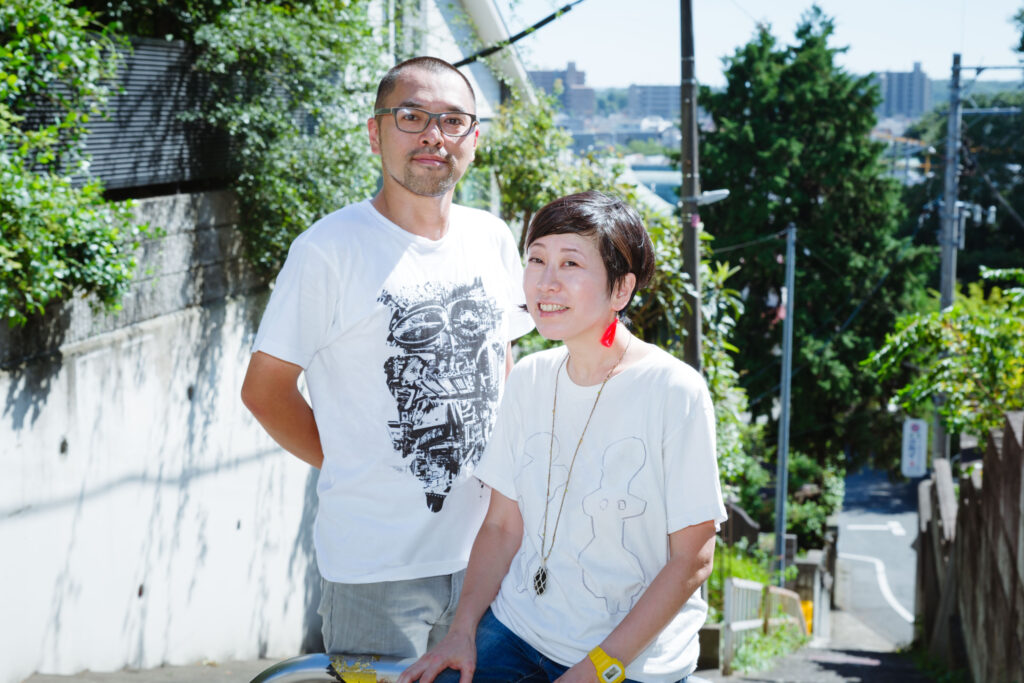
nawa to yajiri
(it means “Rope and Arrowhead”)
A unit for exploring the Jomon by Tomoko Kusakari (writing) and Yoshiaki Hirokawa (photography).
In addition to working as members of the NPO Jomonism, they also travel around Japan visiting Jomon ruins, archaeological sites and local museums, exploring the prehistoric values that can be deciphered from the forms and environments of the Jomon.
http://nawatoyajiri.com